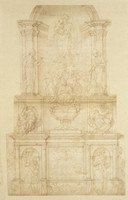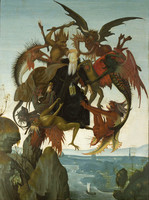


Framed and hanging on a wall at the Metropolitan Museum of Art is a drawing in pen and brown ink depicting a solemn yet serene Virgin Mary and Christ Child sitting before her, gazing lovingly upward and extending His hand to try to touch her face. In the background, other shapes come to life—practice sketches of infants, an adult face looking into the distance (perhaps an early attempt at the Virgin) and a robed figure, hunched and headless as though abandoned in mid-drawing.
Part of the exhibition “Michelangelo: Divine Draftsman and Designer,” which runs through Feb. 12, this piece is one of more than 200 works, mostly drawings by Michelangelo but many others by his contemporaries, with several paintings and sculptures to provide context. The accompanying plaque dubs this piece “the most inventive surviving drawing from Michelangelo’s early years.” It reveals the artist building upon techniques used in several sketches that preceded it chronologically, but this page comes uniquely to life, with cross-hatching combined with parallel hatching lines that curve and contour to give shape to his figures, demonstrating a sculptor’s eye for three-dimensional form.
Moments like these, where the evolution of Michelangelo’s process becomes evident in his art, are the focal point of curator Carmen C. Bambach’s subtle yet ambitious exhibit, which leads viewers on a journey of discovery, more intellectual in nature than the visceral experience elicited from the artist’s grandiose achievements of the Sistine Chapel, the Pieta, and the dome of St. Peter’s Basilica.
Process reveals biography in Ms. Bambach’s exhibit, where the first known painting by Michelangelo, the “Torment of Saint Anthony,” hangs beside a Martin Shongauer print of the same subject. Shongauer created his St. Anthony when he was about 30 and at the height of his artistic abilities, but at 13 Michelangelo used egg and tempera to copy his design and improve upon the scene by reimagining the depicted attack taking place over a seascape, with enhanced fins, scales and eyes for the demons, details Michelangelo sought out in person at a fish market in Tuscany.
At another point in the exhibit, one comes upon a torn page of aged white paper with a sketch credited to Michelangelo, an attribution that renews or perhaps solves a centuries-old mystery of provenance. The black chalk drawing depicts a male nude seated and partially reclined in sleep, with a robed and contemplative cherub-like boy standing off to the side. A few lines of writing above the drawing begin but then disappear where the tear removed almost a quarter of the page at the top right.
In her catalogue accompanying the exhibit, Ms. Bambach attributes the handwriting to Sebastiano del Piombo, a friend and collaborator to whom Michelangelo gifted drawings for the purposes of inspiration. Ironically, the attribution of handwriting to another artist strengthens the case for its being a Michelangelo because it moves the piece’s origin to his inner circle. Additionally and despite the handwriting attribution, Ms. Bambach’s stylistic analysis points to Michelangelo for the drawing, given the signature corrective markings, masterful strokes and lack of pictorialism. She notes that the scene foreshadows Michelangelo’s later work “The Dream of Human Life,” in which an angel sounds a trumpet to awaken a male nude reclining on a globe. Background sketches depict the agony brought about by vice, while masks in the foreground hint at the choices this young man must make in regard to the role he will play in the world.
Michelangelo’s lifelong study of the human form looms large in this exhibit. Sketches of disembodied limbs, torsos, busts and eyeballs reveal concepts in development. An entire room is dedicated to preparatory drawings for the Sistine Chapel, where a study of a torso and outstretched hand seem to frame an early idea for the layout of the entire ceiling. A sketch of God the Father appears on a page beside what looks like a quickly doodled self-portrait of a painter standing on scaffolding and applying his brush to a ceiling, perhaps a humorous outlet for the existential angst he was experiencing at the outset of this monumental assignment.
The final collection of works in this exhibit is dedicated to Michelangelo’s architectural drawings, an end of life preoccupation due to the copious commissions he received in Rome. Through a series of intricate sketches done by Michelangelo himself, as well as other artists who recreated his ideas, one can see how he laid the groundwork for projects that transformed the Roman landscape as they came to fruition in the decades after his death.
This study of the artist’s least visceral and most theoretical take on beauty proves elemental to Ms. Bambach’s ascetic theme. Yet it is a collection of drawings leading up to these architectural works that moves the viewer to glimpse the soul of Michelangelo.
Here his crucifixion drawings contrast markedly with the idealized Neoplatonic style he employed in depicting the human form throughout his life. The musculature of the figures is much less defined, replaced instead by soft, emotive gestures that seem to convey the transcendence of Christ’s sacrificial act and capture the unspeakable sorrow of Mary and John, who mourn at His side.
Intriguing among this last set of figural drawings is “Study for Christ Appearing to His Mother on the Day of the Resurrection.” It captures all of the creative energy displayed in the Virgin and Child he drew in his early years. It is a quick sketch of Christ hovering beside a seated Mary. Both extend their hands to each other. His hand seems calm and welcoming and hers somewhat uncertain yet open to the discovery of joy.
Perhaps this reflects the point to which Michelangelo’s life was always directed. Having internalized the truths he conveyed through the beauty of his art, he was on a deeply spiritual journey as a man. The study of his process in this masterful exhibit reveals a restless, ever-evolving genius, with a soul open to the discovery of joy in the risen Christ.